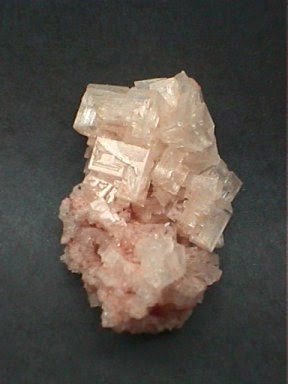I hope you and yours are doing well. I am doing great, thanks be to God! As some of you may know, April commemorates Earth Month! If you are connected with me on Facebook, you will have noticed that every day in the month so far, I've posted interesting tidbits about planet Earth in my Thank You, Mother Earth series. Below is a summary of Earth Month 2015, Week 3:
Day 15: Granite
Granite is a felsic intrusive igneous rock and has been used as a building material for many centuries. The granite mineral composition is composed primarily of quartz, mica and feldspar as well as other minerals. Granites can be predominantly white, pink, or gray in color, depending on their mineralogy. Granite is blasted from quarries in large blocks and then sliced like a loaf of bread to create bundles. The granite slabs in that bundle will match and mimic each other in directionality and color variation. Most slabs are rarely longer than 10 feet long. Granite has tiny pits or spaces between the various mineral crystals. This is caused primarily by Biotite. The extrusive igneous rock equivalent of granite is rhyolite.
Potash is any of various mined and manufactured salts that contain potassium in water-soluble form. The name derives from "pot ash", which refers to plant ashes soaked in water in a pot, the primary means of manufacturing the product before the industrial era. The word "potassium" is derived from potash. Today, potash is produced worldwide at amounts exceeding 30 million tonnes per year, mostly for use in fertilizers. Various types of fertilizer-potash thus constitute the single largest global industrial use of the element potassium. Potassium was first derived by electrolysis of caustic potash (potassium hydroxide), in 1808.
Bauxite, an aluminium ore, is the world's main source of aluminium. It consists mostly of the minerals gibbsite, boehmite and diaspore, mixed with the two iron oxides goethite and haematite, the clay mineral kaolinite and small amounts of anatase. Lateritic bauxites (silicate bauxites) are distinguished from karst bauxite ores (carbonate bauxites). The carbonate bauxites occur predominantly in Europe and Jamaica above carbonate rocks (limestone and dolomite); lateritic bauxites are found mostly in the countries of the tropics. Bauxite is usually strip mined because it is almost always found near the surface of the terrain, with little or no overburden. Bauxite rocks are typically classified according to their intended commercial application: metallurgical, abrasive, cement, chemical, and refractory. Increased aluminium recycling, which has the advantage of lowering the cost in electric power in producing aluminium, will considerably extend the world's bauxite reserves.
Platinum is a soft, dense, ductile metal that is very resistant to corrosion. It is used to make jewelry, wire, electrical contacts and laboratory vessels. Platinum expands at nearly the same rate as soda-lime-silica glass, so it is used to make sealed electrodes in glass systems. Platinum is used to coat missile nose cones, jet engine fuel nozzles and other devices that must operate reliably for long periods of time at high temperatures. Platinum resistance wires are used in high temperature electric furnaces. Platinum anodes are used in cathodic protection systems to prevent ships, pipelines and steel piers from corroding in salt water.
Boron is a vital trace mineral that is required for the normal growth and health of the body. Many dangerous conditions like arthritis and osteoporosis are naturally managed by Boron, and it helps to reduce menopausal symptoms as well. It is believed that boron improves the natural ability of the human body to absorb calcium and magnesium. Boron is able to enhance the testosterone levels in males; this quality is increasingly taken advantage of by male body builders and athletes. Boron neutron capture agents are used for cancer therapy and in the development of strong enzyme inhibitors. Boron can significantly alleviate the difficulties caused by congestive heart failure conditions.
Day 20: Graphite
Graphite is a soft, crystalline form of carbon. Other forms are diamond and fullerenes ("buckyballs"). It is gray to black, opaque, and has a metallic luster. It is flexible but not elastic. Graphite occurs naturally in metamorphic rocks such as marble, schist, and gneiss. It exhibits the properties of a metal and a nonmetal, which make it suitable for many industrial applications. The metallic properties include thermal and electrical conductivity. The nonmetallic properties include inertness, high thermal resistance, and lubricity. Some of the major end uses of graphite are in high-temperature lubricants, brushes for electrical motors, friction materials, and battery and fuel cells.
Ruby B. Johnson,
Your Miss Earth Maryland 2015
Continuing the legacy of beauty and responsibility
Help me compete at Miss Earth United States 2015. DONATE HERE
 |
| Ruby B. Johnson Seeking Sponsors for Miss Earth United States 2015 |








No comments:
Post a Comment